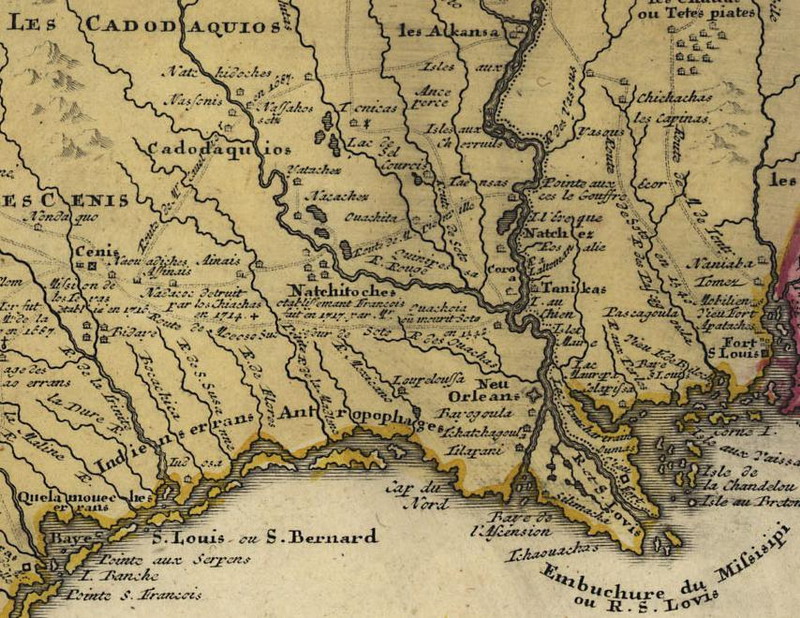|
The Arkansas Post, originally settled by French traders in 1686, near where the Arkansas River meets the Mississippi River, is considered to be the first permanent French settlement in the lower Mississippi River Valley. The area was home to the Quapaw tribe whose village was near the Post. This was a remote, primitive outpost, home to a small group of trappers, hunters and traders.
Nearly a century later, in 1766, when Spain took over the area after the Seven Years War, there were fifty people living at the Post. One of the families living there at the time was the Jardelat family: Pierre, Marie and their three children.
Arkansas Post in the 1700s was a hub of hunting and trading. The area was home to bear, buffalo, beaver, wolves and other animals whose pelts were highly prized. These were traded for highly valued items such as powder and ammunition as well as liquor. The Arkansas River was the primary route for all the trading taking place. It was remote and not easily accessible; to get from New Orleans to the Post up the Mississippi took thirty-five to forty days.
The river could sometimes be a trickle and sometimes a raging flood. Erosion and flooding caused the Post to move to several different locations over the years. Even then, it was a losing battle against the river:
In 1776, Captain Balthazar De Villiers assumed command of the post. He found a pitifully small French and Spanish community of 61 inhabitants all domiciled in 11 rotting dwellings. Only 16 soldiers comprised the garrison. The fort itself was dilapidated from the annual floods. To De Villiers, Arkansas Post was “the most disagreeable hole in the universe.” In 1777, he wrote “all the land has been covered with water for three weeks and the entire harvest has been lost, indeed for the fourth year in a row.1
The soldiers and settlers were only visited occasionally by a priest, so baptisms sometimes took place when a child was several years old. Marguerite Jardelat was born in 1781 but was not baptized until 1792. Marriages were sometimes blessed with a Church ceremony several years after a couple was married. In Abstract of the Catholic Register of Arkansas a comment was noted: “Church ceremony of civil union contracted previously before witnesses due to lack of priest in the area.”2
In 1803 Arkansas Post, as part of the Louisiana Purchase, became part of the United States. By this time there were more Americans moving into the area. Arkansas Post became part of the Arkansas Territory. It is not known where Marie and her younger children went after Pierre died in 1798. Most likely Judit and Joseph, who were younger than thirteen in 1798, stayed with their mother but it is not known where they went. Joseph was in New Orleans for the 1804 census and he appears to have remained there. Alexis and Jean were still in the area of the Post in 1818. Louis was there until 1806, when he died.
Arkansas became a territory in 1819 and Arkansas Post, the largest and most important town, became its capital. In 1821, the capital was moved to Little Rock which was becoming more populous.
In 1929, Arkansas Post became a state park. In 1860 it became part of the National Park System, known as Arkansas Post National Memorial. There are museum exhibits, trails and a visitor center.
|
Related Links and Sources of Information:
Encyclopedia of Arkansas History and Culture
"The Arkansas Post Story: Arkansas Post National Monument, by Roger E. Coleman.
Arkansas Post National Memorial, Gillett, Arkansas.
Arkansas Post Timeline
The Jardelat family of Arkansas Post
-
"The Arkansas River and the Development of Arkansas Post," by Roger E. Coleman, Arkansas Historic Preservation Program. Originally presented as a paper at Arkansas Post National Memorial on May 18, 1991 for the tenth annual Arkansas Heritage Week. Arkansas Post National Memorial Webpage: http://www.nps.gov/archive/arpo/history/coleman.htm.
-
Abstract of Catholic Register of Arkansas (1764-1858), Core, Dorothy Jones, compiler and editor. DeWitt, Arkansas, Grand Prairie Historical Society, 1976, p.20.
|

